Tuesday Oct. 17, 2006
Quiz #2 was returned in class today. The average grade was
70%. Be sure to carefully check the grading on your quiz.
The Experiment #2 reports have been graded
and were returned in class. You have two weeks to revise your
report. Revised reports are due in two weeks on Tue., Oct.
31. Please return the original report with your revised report.
A few
remaining sets of Experiment #3 materials
are still available for checkout.
The 1S1P Assignment #2a reports are due
Thursday this week (Oct. 19). The Assignment
#2b reports are due next Tuesday (Oct. 24). The Surface
Weather Map Analysis worksheet is now available.
Coming on Thursday: two new optional assignments.
Coming next week: Experiment #4
Now
we
move to an important new topic: humidity. The beginning of
Chapter 4 can be a little overwhelming and confusing. If you find
it too confusing, I would suggest you stop reading and not worry
too much about it. Study the class notes and
once you feel comfortable with the material there you can go back and
read the beginning of Chapter 4.
A brief introduction to some of the humidity variables is
given on p.
83 in the photocopied notes.
We will be mainly interested in 4 variables: mixing ratio, saturation
mixing ratio, relative humidity, and dew point.
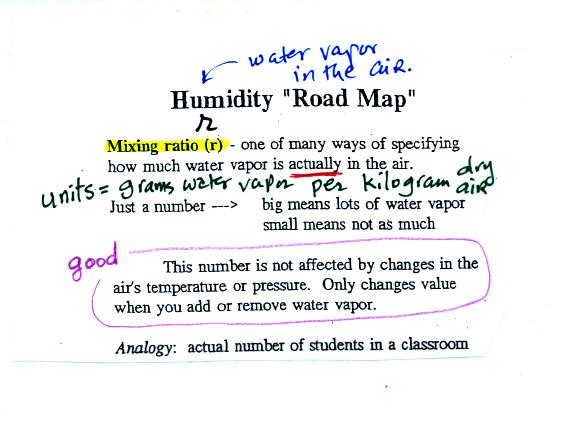
Mixing ratio tells you how much water vapor is actually
in
the
air. Mixing ratio has units of grams of water vapor per kilogram
of dry air (how much water vapor in grams is mixed with a
kilogram
of dry air). It is basically the same idea as teaspoons of sugar
mixed in a cup of tea.
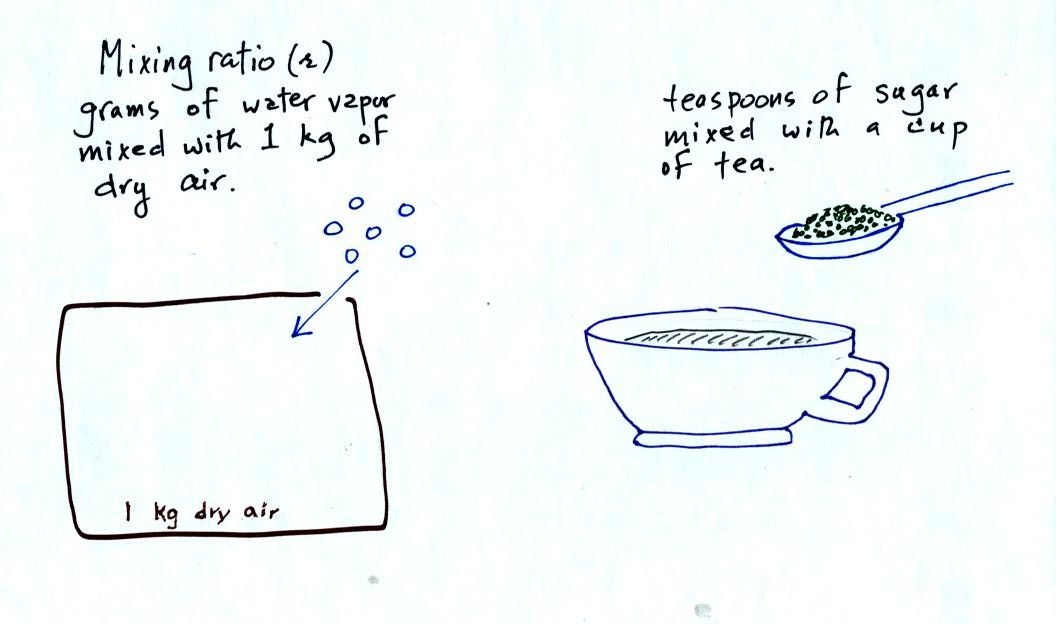
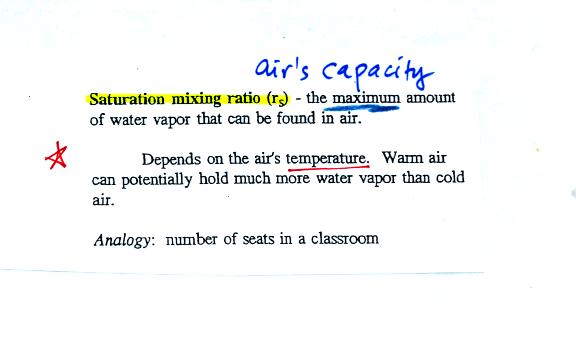
Saturation
mixing ratio is just an upper limit to how much
water vapor
can be found in air. It doesn't say anything about how much water
vapor is actually in the air (that's the mixing ratio's job).
Warm air can potentially hold more water vapor than cold air.
This variable has the same units: grams of water vapor per kilogram of
dry air.
The dependence of saturation mixing ratio on air temperature is
illustrated below:

The small specks represent all of the gases in air except
for the water
vapor. Each of the open circles represents 1 gram of water vapor
that the air could hold. There are 15 open circles drawn in the 1
kg of 70 F air; each 1 kg of 70 F air could hold up to 15 grams of
water vapor. The 40 F air only has 5 open circles; this cooler
air can only hold up to 5 grams of water vapor per kilogram of dry air.

Now we have gone and actually put some water vapor into
the
volumes of
70 F and 40 F air. 3 grams of water vapor have been added to each
volume of air. The mixing ratio, r, is 3 g/kg.

The relative
humidity tells you how "full" the air is with water
vapor. If you think of the student/classroom analogy, a
classroom with 16 seats (analogous to the saturation mixing ratio)
contains 4 students (analogous to the mixing ratio). The
classroom would be 25% full.

Here are the relative humidities of the 70 F and 40 F air that each
contain 3 grams of water vapor. The 70 F air has a low RH because
this warm air's saturation mixing ratio is large. The RH in the
40 F is higher even though it has the same actual amount of water vapor
because the 40 F air can't hold as much water vapor and is closer to
being saturated.
You can see how RH doesn't really tell you how much water vapor is
actually in the air. The two volumes of air above contain the
same amount of water vapor (3 grams per kilogram) but have different
relative humidities.
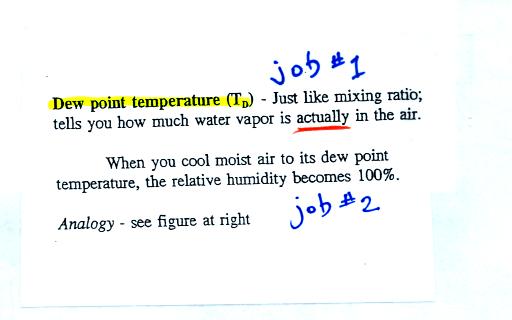
The dew point temperature has two jobs. First it is a
measure of
the actual amount of water vapor in the air. In this respect it
is just like the mixing ratio. If the dew point temperature is
low the air doesn't contain much water vapor. If it is high the
air contains more water vapor.
Second the dew point tells you how much you must cool the air in order
to cause the RH to increase to 100% (at which point a cloud, or dew or
frost, or fog would form).
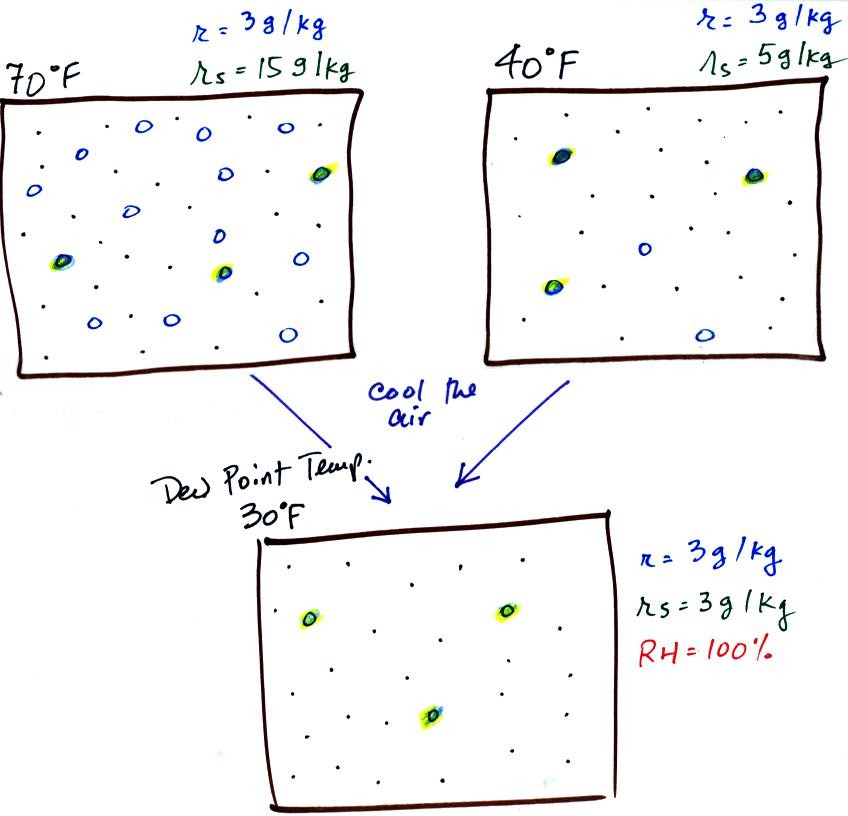
If we cool the 70 F air or the 40 F air to 30 F we would
find that the
saturation mixing ratio would decrease to 3 grams/kilogram. Since
the air actually contains 3 g/kg, the RH of the 30 F air would become
100%. The 30 F air would be saturated, it would be filled to
capacity with water vapor. 30 F is the dew point temperature for
70 F air that contains 3 grams of water vapor per kilogram of dry
air. It is also the dew point temperature for 40 F air that
contains 3 grams of water vapor per kilogram of dry air.
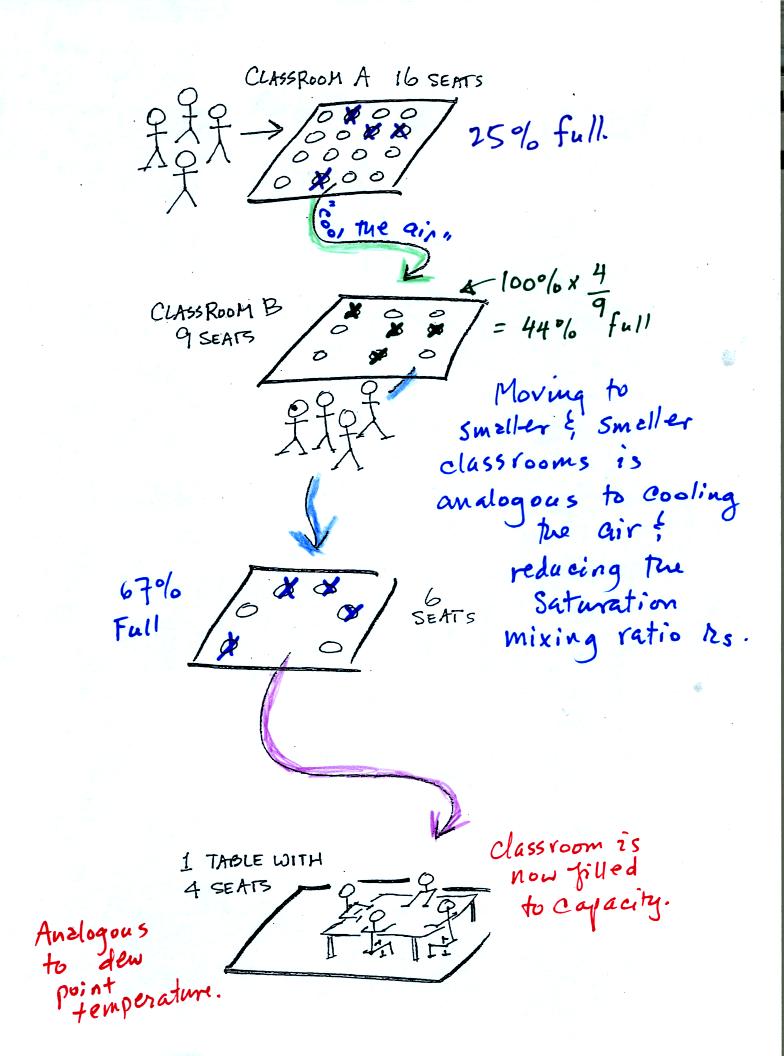
Now back to the students and classrooms analogy on the righthand
side of p. 83. The 4 students
move into classrooms of smaller and smaller capacity. The
decreasing capacity of the classrooms is analogous to the
decrease in saturation mixing ratio that occurs when you cool
air. Eventually the students move into a classroom that they just
fill to capacity. This is analogous to cooling the air to the dew
point temperature, at which point the RH becomes 100% and the air is
filled to capacity, the air is saturated with water vapor.
The number of students is analogous to the
mixing ratio
The classroom capacity is analogous to the saturation mixing ratio
The relative humidity is analogous to how full a classroom is
Moving from smaller and smaller rooms until the students just fill a
room is analogous to cooling the air to the dew point temperature.
Next we
will try to understand better why it is possible to saturate air with
water vapor. Why is there an upper limit to the amount of water
vapor that air can contain? Why does this upper limit depend on
air temperature?
First we need to understand that the rate at which water evaporates
depends on the water's temperature.

To be able to evaporate a water molecule must make its way
up to the
surface of the water and the water molecule must have sufficient energy
to overcome any attractive forces trying to keep it in a liquid
state. In cold water only a limited number of the water molecules
have the necessary energy - cold water has a low rate of
evaporation. In hot water, a larger fracton of the water
molecules will have enough energy, hot water evaporates more rapidly.
In many respects this is like a grade distribution for a class.
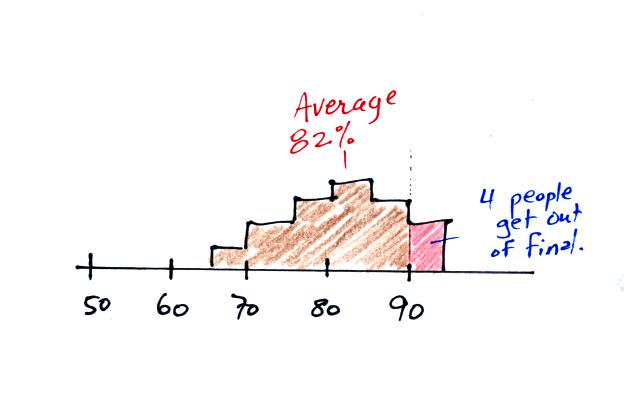
The 4 people that don't have to take the final exam in the
example above (because they have an average grade of 90.0% or above) is
analogous to the water molecules that have enough energy to evaporate.
If we were to add 5% points to the grade of everyone in the
class, the class average would increase. This would be like
warming some water. The increase in water temperature would be
telling you that the average kinetic energy of the water molecules had
increased.
Adding 5% to everyone's grade would also mean that more students
wouldn't have to take the final exam. In the case of the water,
more water molecules would have the kinetic energy needed to evaporate.

Now we
will look at the top part of p. 85 in the photocopied
notes. We have put a cover on the glass of room temperature
water.

In #1 we see that the water is evaporating (2 arrows worth
of
evaporation). Water vapor will begin to build up in the air in
the glass. This is shown in #2. Some of the water vapor
molecules will condense (even though they may have just
evaporated). In Fig. #3 the amount of water vapor has built up to
a point where there is one arrow worth of condensation. In #3
there is still more evaporation than condensation so the water vapor
concentration will increase a little bit more. Eventually in #4
the water vapor concentration has increased to a point that there are
two arrows of condensation. This balances the 2 arrows of
evaporation. The air is saturated, the air is filled to
capacity. The amount of water vapor in the air will remain
constant.
What would happen if we took off the cover and added some
more water
vapor to the glass in Fig. #4? This is the question that I told you
think about and mentioned that I would put the answer in the online
notes. The figure below wasn't shown in class.

The air in Fig. #5 shows what would happen. The air
would be supersaturated
with water vapor and the RH would be greater
than 100%. This is possible but it is not an equilibrium
situation. The increased amount of water vapor would increase the
rate of condensation. There would be more condensation than
evaporation. The water vapor concentration would begin to
decrease. Eventually the glass would end back at the equilibrium
situation in Fig. #4.
If we look at the bottom of p. 85 we see that the air in all
three cases is
saturated (equal rates of evaporation and condensation in each
case). The relative humidity is 100% in all three cases.
The amount of water vapor in the air however is different. The
warm air contains a lot more water vapor than the cold air.
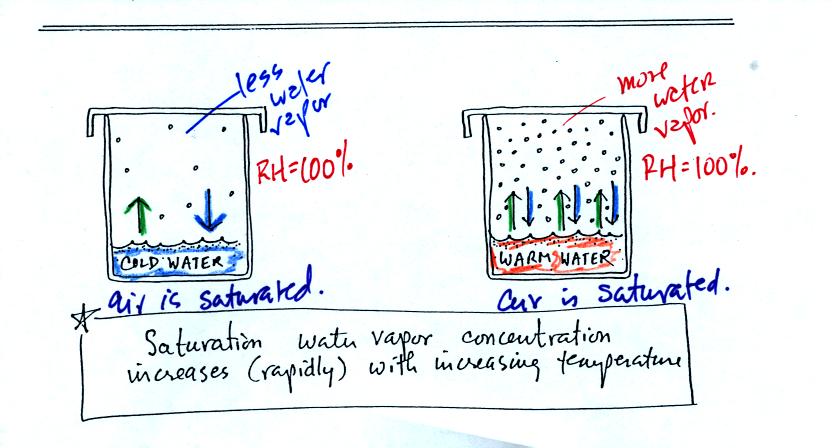
This
information is on p. 86 in the photocopied class notes.
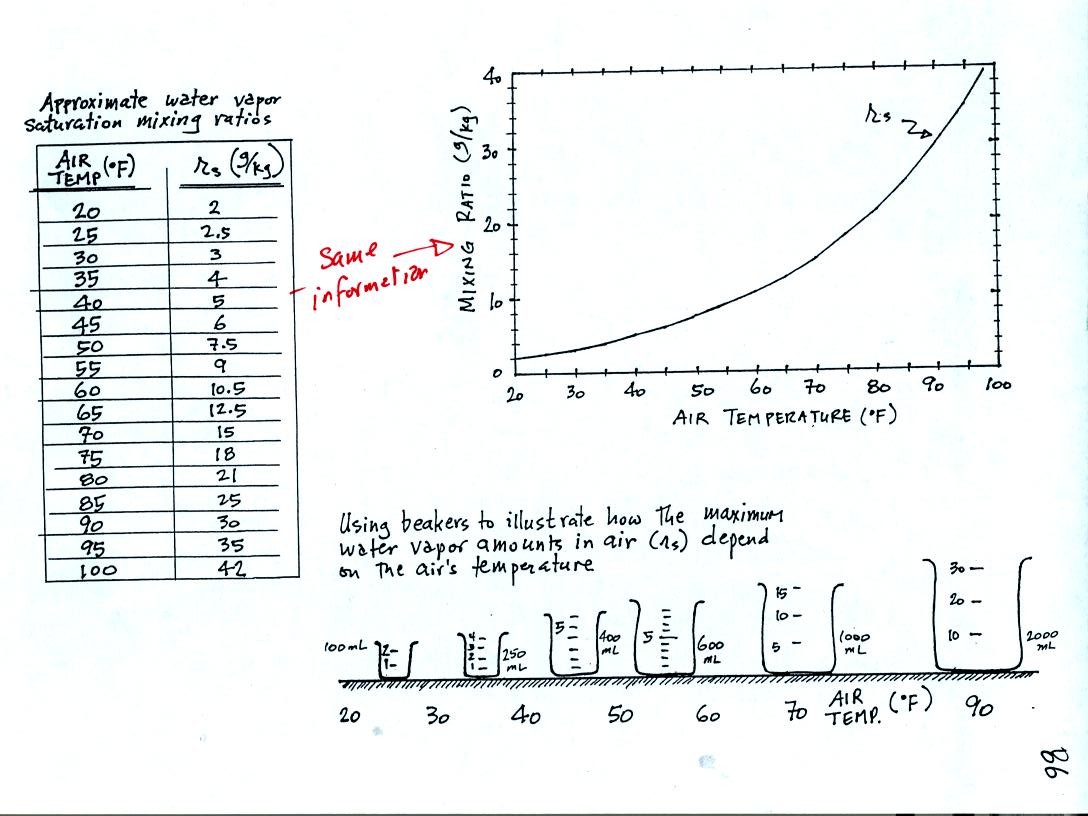
This page just gives you saturation mixing ratio values as a function
of air
temperature. The data are listed in a table and plotted on a
graph.
The beakers are meant to show graphically the relative amounts of water
vapor that air at different temperatures can contain. Don't get
the idea that you could evaporate 2 L of water into a kilogram of 90 F
air. The 90 F air couldn't contain anywhere near that much water
vapor. What the 90 F beaker does show is that 90 F air can
contain twice as much water vapor as 70 F air.
Now we'll
work a series of humidity problems. By doing this you should
begin to get a better feeling for what the various humidity variables
are and how they work. Pay particular attention to what causes
them to change.
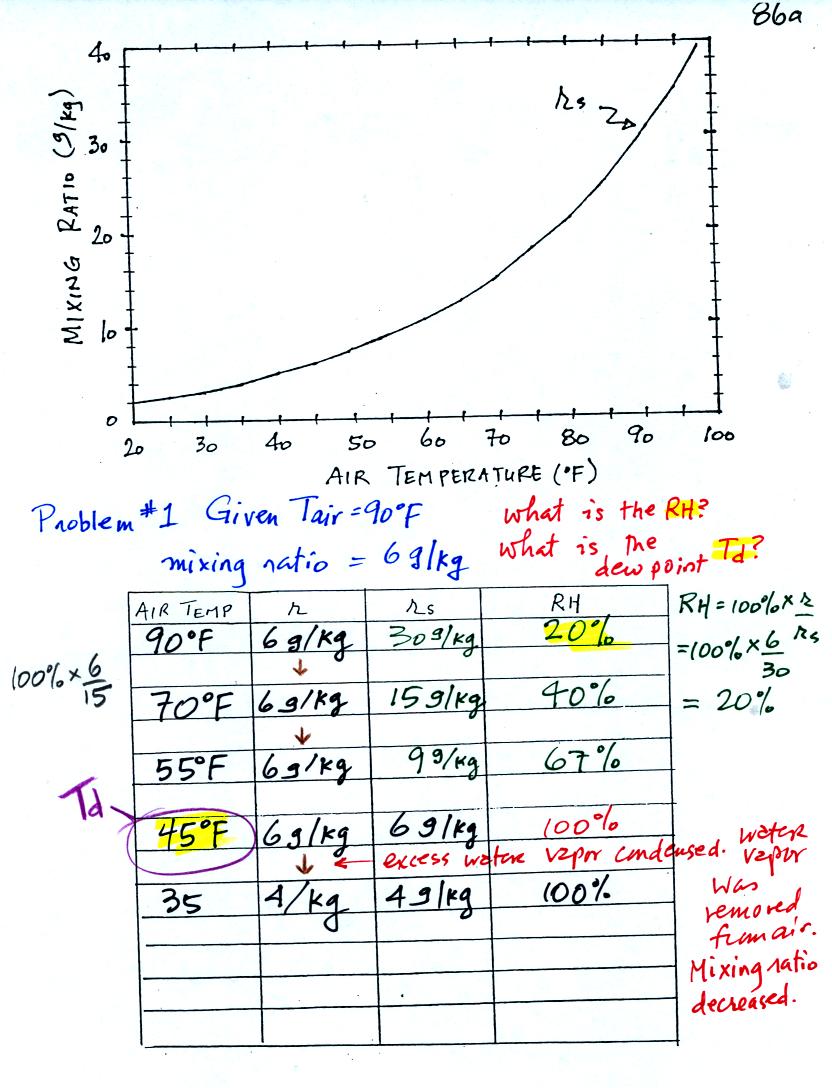
Here is the first sample problem that we worked in
class.
You might have a hard time unscrambling this if you're seeing it for
the first
time. The series of steps that we followed are retraced
below:

We're given an air temperature of 90 F and a mixing ratio
(r) of 6
g/kg. We're first supposed to find the relative humidity (RH).
We start by entering the data we were given in the
table. Once
you know the air's temperature you can look up the saturation mixing
ratio value; it is 30 g/kg for 90 F air. 90 F air could
potentially hold 30 grams of water vapor per kilogram of dry air (it
actually contains 6 grams per kilogram in this example).
Once you know mixing ratio and saturation mixing ratio you
can
calculate the relative humidity.
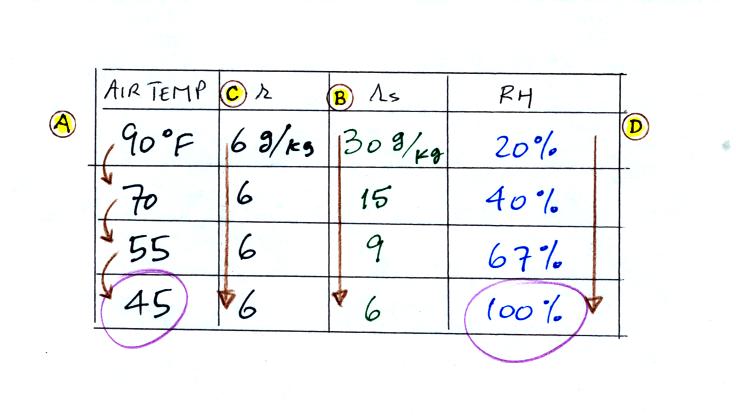
The numbers we just figured out are shown on the top line
above.
(A) We imagined cooling the air from 90F to 70F, then to 55F, and
finally to 45F.
(B) At each step we looked up the saturation mixing ratio and entered
it on the chart. Note that the saturation mixing ratio values
decrease as the air is cooling.
(C) The mixing ratio doesn't change as we cool the air. The only
thing that changes r is adding or removing water vapor and we are doing
neither.
(D) Note how the relative humidity is increasing as we cool the
air. The air still contains the same amount of water vapor it is
just that the air capacity is decreasing.
Finally at 45 F the RH becomes 100%. The dew point temperature in
this problem is 45 F.
What would happen if we cooled the air further still, below the dew
point temperature.
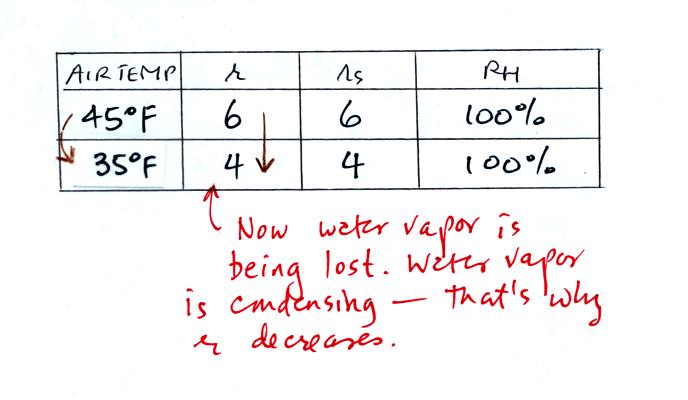
35 F air can't hold the 6 grams of water vapor
that 45 F air can. You can only "fit" 4 grams of water vapor into
the 35 F air. The remaining 2 grams would condense. If
this happened at ground level the ground would get wet with dew.
If it happens above the ground, the water vapor condenses onto small
particles in the air and forms fog or a cloud. Now because water
vapor is being taken out of the air (and turned into water), the mixing
ratio will decrease from 6 to 4.

In many ways this is liking squeezing a moist sponge (squeezing
the
sponge and reducing its volume is like cooling moist air and reducing
the saturation mixing ratio). At first when you sqeeze the sponge
nothing happens, no water drips out. Eventually you get to a
point where the sponge is saturated. This is like reaching the
dew point. If you squeeze the sponge any further (or cool air
below
the dew point) water will begin to drip out.

The second problem is shown above. Given an air
temperature
of 90
F and a relative humidity of 50% you are supposed to figure out the
mixing ratio (15 g/kg) and the dew point temperature (70 F). The
problem is worked out in detail below.
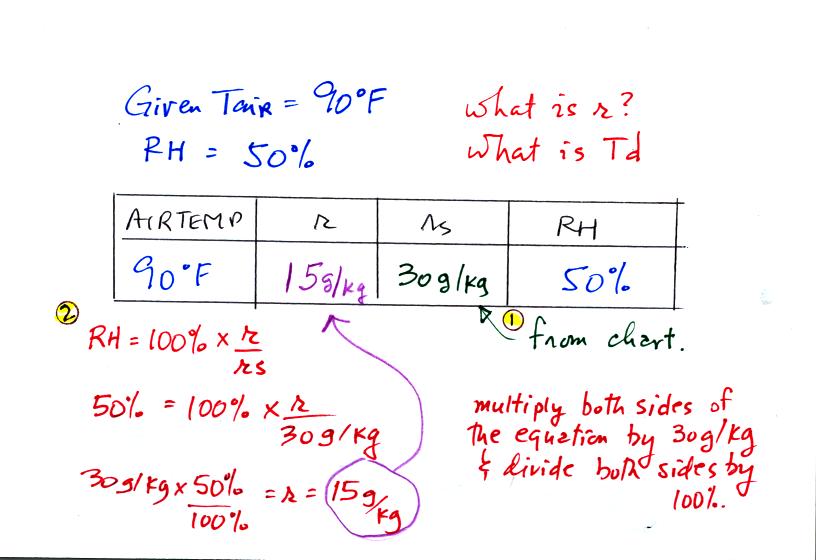
First you fill in the air temperature and the RH data that
you are
given. Since you know the air's temperature you can look up the
saturation mixing ratio (30 g/kg). Then you can substitute into
the relative humidity formula and solve for the mixing ratio (15 g/kg).
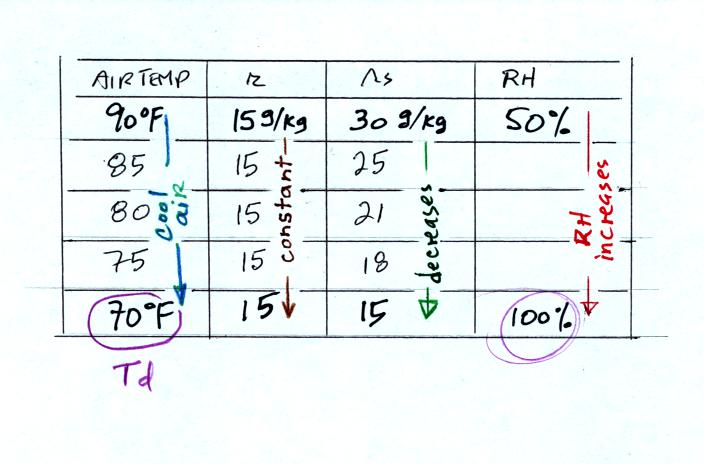
Finally you imagine cooling the air. Cooling causes
the
saturation mixing ratio to decrease, the mixing ratio stays constant,
and the relative humidity increases. In this example the RH
reached 100% when the air had cooled to 70 F. That is the dew
point temperature.
There's
something more you can learn from these two examples.
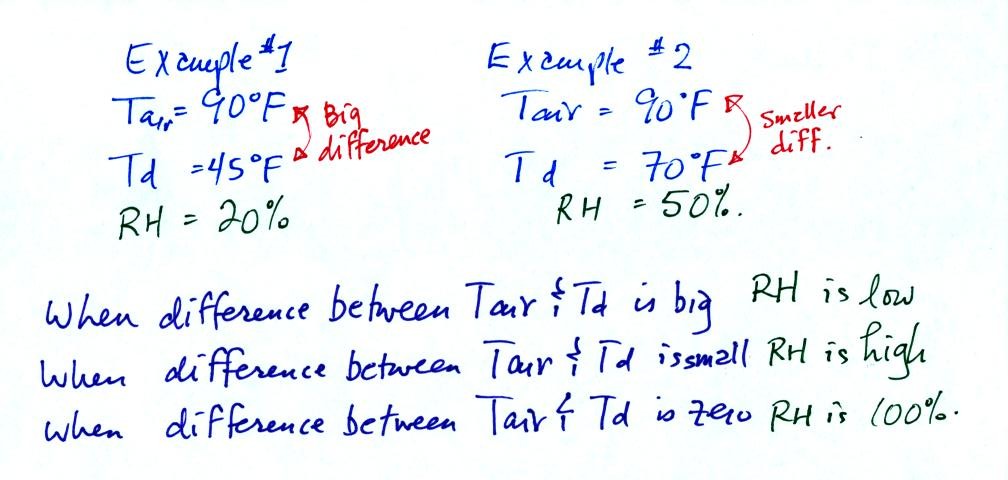
In the first
example the RH was low and the difference between the air and dew point
temperatures was large. In the second example, the RH was higher
and the difference between the air and dew point temperatures was
smaller. If there were no difference between the air and dew
point temperature the RH would be 100%.
Can't wait until Thursday to see the remaining two humidity
questions? Check the Thursday Oct. 19 notes.
This final
portion of the online notes was a brief introduction to Experiment #3.
The
two collectors below have been placed outside in the sunlight.
They have been tilted at just the right angle so that the rays of
sunlight strike them directly.
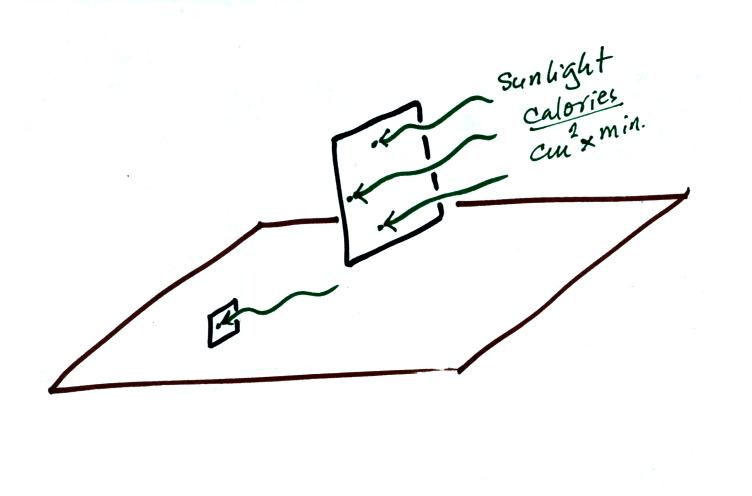
What does your intuition tell you? Would the larger collector
absorb MORE energy
than, LESS energy than, or the SAME amount of
energy as the smaller collector?
What about the following situation? Two collectors with the same
crossectional area are left out in the sun for different amounts of
time.
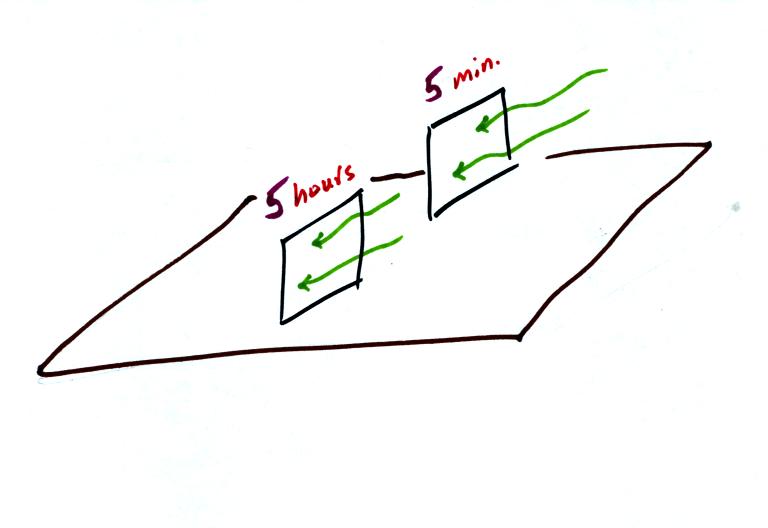
Will the collector that is left out for only 5 minutes absorb the same
total amount of energy as the collector that is left in the sun for 5
hours? No, the
collector left out for 5 hours will absorb a lot more energy than the
collector left out for 5 minutes.
The energy absorbed by a collector will depend on the intensity of the
sunlight, the area of the collector, and the amount of time the
collector is left in the sun.

The variable S is the intensity of sunlight term. It is called
solar irradiance and has units of calories per cm2 per
minute. That is what the people doing Experiment #3 are trying to
measure.
A collector that starts to absorb energy will heat up (think of your
car left out in the sun).
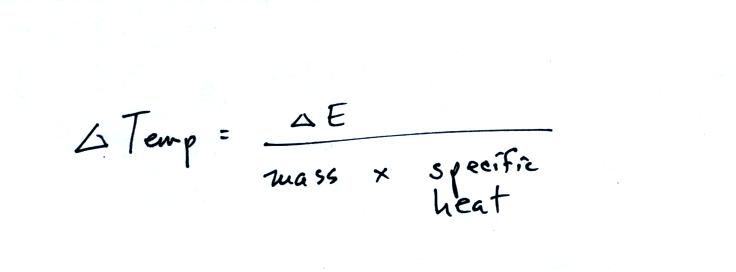
Here's that equation again. Now replace the energy term in this
equation with the energy term from the other equation.
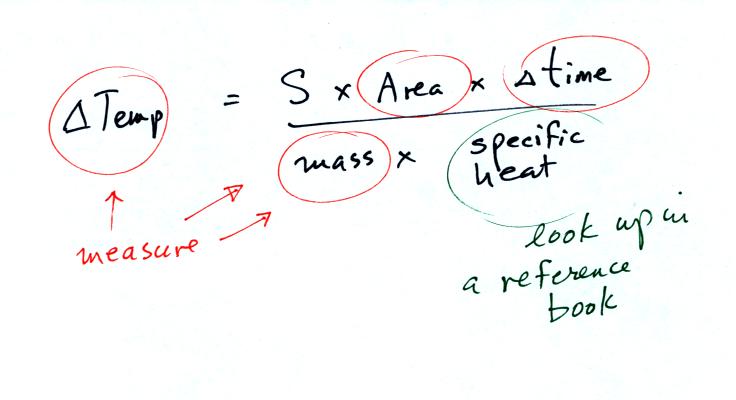
You can either measure or look up every term in this equation except
for S.

The object of the solar irradiance experiment is to measure the solar
irradiance, i.e. the energy in sunlight. You place a small block
of aluminum outside in the sun and measure how quickly it warms
up. You are given values for the mass and specific heat of the
block and you can easily measure it's area.































